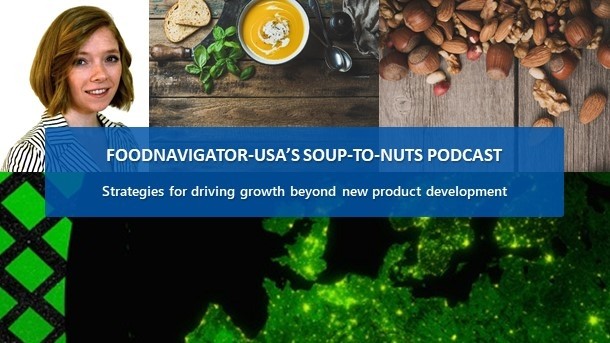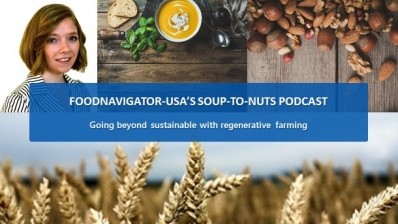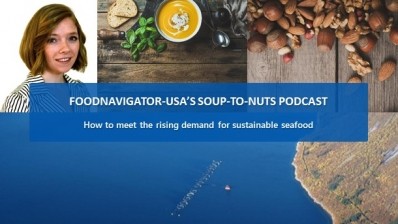Soup-to-Nuts Podcast: Strategies to fuel growth beyond new product development

In Deloitte’s recently released Consumer Products Industry Outlook, the research firm notes that unemployment in the US reached a record low of 4.2% last September with about 148,000 jobs added monthly. Real disposable income was up by 1.8% in 2017 and on track to rise by more than 2% this year. At the same time, US consumers are benefiting from low inflation.
All of these factors helped consumer confidence rise nearly 16% in 2017 over the year before – setting the foundation for shoppers to spend more this year. To capitalize on this growth, as well as an overall improving global economy, Deloitte suggests US CPG companies focus on expanding into new retail markets globally and diversify their distribution channels both on and offline. It also suggests companies consider new alliances to help fuel innovation – not just of products, but also processes.
In this episode of FoodNavigator-USA’s Soup-To-Nuts Podcast, Barb Renner, Deloitte’s vice chairman and the US consumer products leader, explains what each of these strategies entails and how companies can maximize their impact. An executive from the maker of Otis Spunkmeyer also provides a real world example of innovation through renovation.
Expanding globally
Given the US economy’s stability it may be tempting to focus on home front, but Renner explained that because the US is steady, firms have more resources now to focus outward. Plus, she notes that the US’s current case, steady treads uncomfortably close to stagnant, at least in terms of who is buying.
“Most consumer product companies obviously have a growth plan, and that growth plan is somewhere in the neighborhood of 7-9%, and with the US population growing 2-3% organically,” companies are looking to other markets around the world to fuel growth, she said.
She explains one reason companies are attracted to emerging markets is because their populations are growing much more quickly than in the US, as is the size of their middle class, which means more people spending more money.
For example, in India 65% of population is under the age of 35 years, which represent current and future shoppers. In the US, on the other hand, only 46% of the population is under the age of 35 years.
At the same time, the global middle class is growing with a predicted 66% of people qualifying for this bracket by 2030 compared to 28% in 2009, according to Deloitte.
A closer look at shifting demographic trends also shows that as companies expand into global markets they will need to change their perceptions as they relate to gender and shopping.
According to Deloitte, women are becoming “’prominent creators of wealth,” and will control 75% of all household spending by 2028. In addition, the US Bureau of Labor Statistics points out that 29.3% of women earned more in 2013 than their husbands compared to 17.8% in 1987.
Altering marketing for evolving gender dynamics around the world may be easier than changing marketing for different generations around the world. Renner explains that companies must refrain from just targeting only younger shoppers who happen make up the largest portion of the shopper base, and the best way to do that is to continue on the path to digitization.
Expanding in ecommerce and other channels
On that note, Renner says that optimizing digital consumer communication and ecommerce are fundamental to fueling future growth.
According to Deloitte’s report, online sales may represent only a small portion of packaged food and beverage sales currently, but it is growing fast with only sales of consumer products expected to grow 350% to $36 billion in 2018 from $8 billion in 2013. For context, offline sales grew only 3.6% in the same period.
Unfortunately, figuring out how to tap into this growth is still a work in progress for many companies, Renner notes.
Renner acknowledges it is probably easier for startups to double-down on ecommerce in part because they are willing to try and fail, as long as the fail fast. In general, they also are able to attract the talent that they need to maneuver more easily online in part because the values of startups usually align more easily with those in the tech scene.
One way that Renner says larger companies can attract employees who can help build their digital presence is by embracing a social mission and catering to the demands of emerging consumer capitalism.
Forging new alliances to fund change
Another way to attract the talent necessary to drive growth through innovation is through acquisition or by forging new alliances, according to Renner.
She explains that companies know they need to stay at the forefront of disruption, and one way they are doing that is by partnering with other companies or people along the supply chain to access capital, talent and an innovative environment.
Before startups form an alliance with a larger company, Renner suggests they consider their capital needs, their current access to market and consumers and if those are elements that they can grow organically overtime, or if they need immediate help.
Bold innovation also might not require alliances – or even a new product or process, Renner says. She explains that many companies – especially those with iconic brands are fueling growth with innovation through renovation of their existing brands to meet new consumer demands.
One such brand is Otis Spunkmeyer, which is in the process of reformulating its iconic sweets with “no funky stuff.”
Jonathan Davis, who is the senior vice president of research & development for ARYZTA, explains what the reformulation is based on, what inspired it and how it is driving growth.
“The no funky stuff [tagline] was our initiative to really address our ingredient declaration and understanding that the consumer is looking for cleaner ingredients, ingredients they can understand, ingredients they can relate to. So we took a look at some of our formulates, especially the top tier line of cookies,” and eliminated “trans fats, not partially hydrogenated oils, no artificial flavors and you know trying to make it look like a cookie you would make at home,” he said.
He added that the retailer and consumer response has been positive.
Based on these examples, each of these growth strategies offer companies different opportunities and raise different challenges. And while brands should pick the ones that work best for them in their current situation, Deloitte notes that ultimately all of these changes may need to be addressed in the near term in order for firms to stay relevant.










